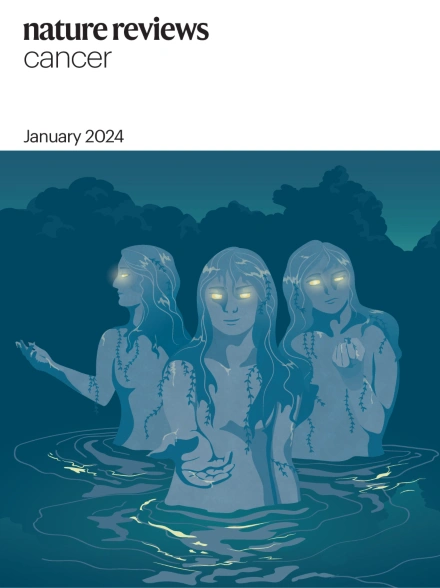小细胞肺癌异质性和表型可塑性的挑战
IF 66.8
1区 医学
Q1 ONCOLOGY
引用次数: 0
摘要
小细胞肺癌(SCLC)是一种侵袭性神经内分泌恶性肿瘤,5年总生存率约7%,反映了早期转移和快速获得性化疗耐药。免疫治疗可短暂延长约15%病例的总生存期,但缺乏预测性生物标志物。靶向治疗开始显示出希望,最近批准的delta-like ligand 3 (DLL3)靶向治疗影响了治疗领域。患者忠实模型的可用性增加,人类肿瘤生物库的积累和大量全面的分子谱研究共同促进了对肿瘤间和肿瘤内异质性的绘制和理解。除了几乎普遍存在的野生型p53和RB1缺失外,SCLC的特点是MYC家族成员、yes相关蛋白1 (YAP1)、NOTCH通路信号、抗凋亡BCL2和表观遗传调节因子的异质失调表达。分子亚型基于神经源性转录因子achaeet -鳞片同源物1 (ASCL1)和神经源性分化因子1 (NEUROD1),罕见的非神经内分泌转录因子POU2类同源物盒3 (POU2F3),以及免疫和炎症相关的特征。此外,SCLC表现出表型可塑性,包括由NOTCH信号驱动的神经内分泌向非神经内分泌的转变,这与疾病进展、化疗耐药和免疫调节有关,在小鼠模型中还与转移有关。尽管这些特征带来了巨大的挑战,但了解转录因子亚型的分子脆弱性,可塑性和细胞合作的功能相关性为根据液体和组织生物标志物进行个性化治疗提供了机会。本文章由计算机程序翻译,如有差异,请以英文原文为准。


Challenges of small cell lung cancer heterogeneity and phenotypic plasticity
Small cell lung cancer (SCLC) is an aggressive neuroendocrine malignancy with ~7% 5-year overall survival reflecting early metastasis and rapid acquired chemoresistance. Immunotherapy briefly extends overall survival in ~15% cases, yet predictive biomarkers are lacking. Targeted therapies are beginning to show promise, with a recently approved delta-like ligand 3 (DLL3)-targeted therapy impacting the treatment landscape. The increased availability of patient-faithful models, accumulating human tumour biobanks and numerous comprehensive molecular profiling studies have collectively facilitated the mapping and understanding of substantial intertumoural and intratumoural heterogeneity. Beyond the almost ubiquitous loss of wild-type p53 and RB1, SCLC is characterized by heterogeneously mis-regulated expression of MYC family members, yes-associated protein 1 (YAP1), NOTCH pathway signalling, anti-apoptotic BCL2 and epigenetic regulators. Molecular subtypes are based on the neurogenic transcription factors achaete-scute homologue 1 (ASCL1) and neurogenic differentiation factor 1 (NEUROD1), the rarer non-neuroendocrine transcription factor POU class 2 homeobox 3 (POU2F3), and immune- and inflammation-related signatures. Furthermore, SCLC shows phenotypic plasticity, including neuroendocrine-to-non-neuroendocrine transition driven by NOTCH signalling, which is associated with disease progression, chemoresistance and immune modulation and, in mouse models, with metastasis. Although these features pose substantial challenges, understanding the molecular vulnerabilities of transcription factor subtypes, the functional relevance of plasticity and cell cooperation offer opportunities for personalized therapies informed by liquid and tissue biomarkers. In this Review, Simpson et al. summarize the emergent understanding of molecular subtypes of small cell lung cancer (SCLC). They discuss how intratumour heterogeneity and dynamic tumour plasticity may challenge the success of immune and molecular subtype-targeted therapies and argue that combination therapies, monitored by serial liquid biopsy-based biomarkers, will be needed to improve the outcomes of patients with SCLC.
求助全文
通过发布文献求助,成功后即可免费获取论文全文。
去求助
来源期刊

Nature Reviews Cancer
医学-肿瘤学
CiteScore
111.90
自引率
0.40%
发文量
97
审稿时长
6-12 weeks
期刊介绍:
Nature Reviews Cancer, a part of the Nature Reviews portfolio of journals, aims to be the premier source of reviews and commentaries for the scientific communities it serves. The correct abbreviation for abstracting and indexing purposes is Nat. Rev. Cancer. The international standard serial numbers (ISSN) for Nature Reviews Cancer are 1474-175X (print) and 1474-1768 (online). Unlike other journals, Nature Reviews Cancer does not have an external editorial board. Instead, all editorial decisions are made by a team of full-time professional editors who are PhD-level scientists. The journal publishes Research Highlights, Comments, Reviews, and Perspectives relevant to cancer researchers, ensuring that the articles reach the widest possible audience due to their broad scope.
 求助内容:
求助内容: 应助结果提醒方式:
应助结果提醒方式:


